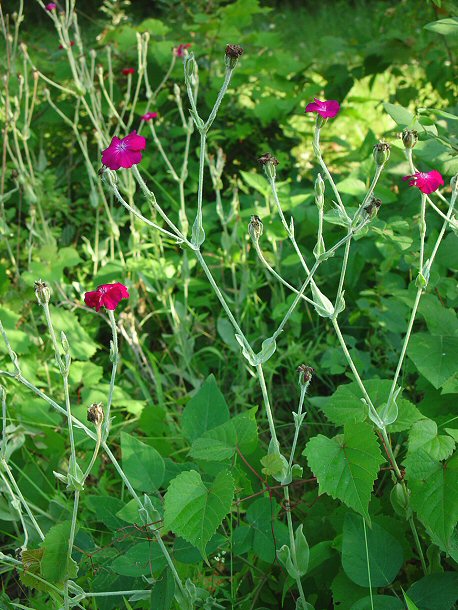Lychnis coronaria (L.) Desr.
Mullein-Pink

Introduced
CC = *
CW = 5
MOC = 6
© DETenaglia
Lychnis coronaria (L.) Desr.Mullein-Pink | |
 |
Introduced CC = * CW = 5 MOC = 6 |
© DETenaglia |
|
Family - Caryophyllaceae Habit - Perennial forb, often with a woody rootstock. Stems - To -1m tall, erect, multiple from the base, branching, lanate, herbaceous but stout, mostly terete.
Leaves - Basal leaves in a rosette, spatulate, acute, often with wavy or slightly crisped margins, lanate, to +15cm long, +6cm broad. Cauline leaves opposite, sessile, ovate to ovate-lanceolate, entire, acute, reduced upwards, lanate.
Inflorescence - Loose divaricate cymes. Single flowers terminating each peduncle. Each division of the cymes subtended by a pair of foliaceous bracts. Bracts lanate, lanceolate-ovate. Peduncles to 8cm long (in fruit), shorter in flower. Flowers - Petals 5, long-clawed, distinct. Claw to 1.3cm long, whitish, somewhat firm, glabrous, with two apical lobes. Lobes erect, subulate, to +/-3mm long, glabrous, lilac. Limb deep pinkish-purple (wine), more dull below (abaxially), to 1.5cm long and broad, glabrous, with slightly erose margins. Stamens 10, included, adnate below the ovary at the base of the petal claws, erect. Filaments white, with hairs at the very base, otherwise glabrous, to 1.2cm long. Anthers brownish, 2mm long. Styles 5, bent at the base and ascending, white glabrous, 5-6mm long. Ovary superior, obovoid (becoming ovoid in fruit), green to greenish-yellow, 4mm long, 3mm in diameter, unilocular. Placentation free-central. Calyx 5-lobed, 10-nerved, accrescent, lanate. Lobes to 5-6mm long in flower, acute to acuminate. Capsule glabrous, many-seeded. Seeds to 1.2mm long, brown.
Flowering - June - August. Habitat - Cultivated and persistent around old homesites. Origin - Native to Europe. Lookalikes - Silene caroliniana. Other info. - This striking species is widely cultivated but not yet found escaped in Missouri. I photographed it growing as an adventive in a conservation area in the southern part of the state. The plant is easy to identify because of its lanate stems, opposite leaves, and brilliant win-colored flowers. It grows well from seed. Photographs taken near Springfield, MO., 7-4-03. |